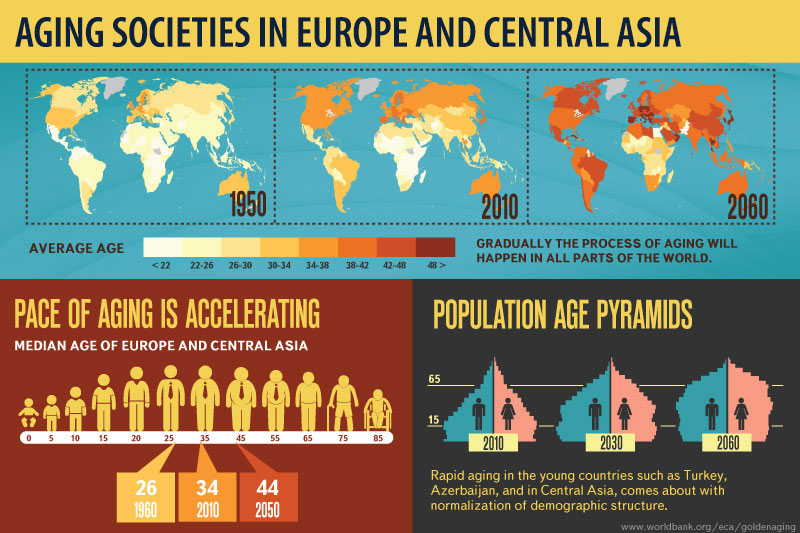Download the report: Golden Aging: Prospects for Healthy, Active and Prosperous Aging in Europe and Central Asia
Overview
The Europe and Central Asia region has among the oldest populations in the world. Europe, in particular, is approaching the end of a demographic transition toward population stabilization, and Central Asia, although still younger, is following quickly.
Aging in Europe and Central Asia is different from that in Western Europe and East Asia in that populations are aging, while people are not necessarily living longer. The rise in the average age is largely attributable to a decrease in fertility rather than to an increase in longevity. Today, life expectancy at birth is 73 years, three years lower than in East Asia and a full ten years behind Western Europe. In many countries in Europe and Central Asia, the emigration of young people has also accelerated the aging of their societies.
More often than not, the aging of a population is a source of concern, given the potential for higher health care and pension costs, increasing dependency, lower growth, unsustainable fiscal deficits, and intergenerational tensions. Demographic trends are frequently viewed as unstoppable and as an inevitable cause of increasing economic costs. However, individuals and firms change their behavior in response to changing conditions, and policy can help or hinder adaptation to demographic shifts.
Aging societies are not destined to experience stagnation or a decline in living standards. However, the behavioral changes that help reduce dependency and sustain productivity do not necessarily happen automatically. A supportive environment, including the right incentives and policies, can facilitate this transition.
In Europe and Central Asia, bold adaptive action is needed across many policy areas to support active, healthy, and productive aging. These areas include much more than reforming the intergenerational transfer and pension systems: they encompass, among others, shifting health systems toward preventive care, primary care, and more diagnostics; reforming educational systems to bolster the cognitive skills needed for productive employment along longer working lives; and reforming labor market institutions to allow women to reconcile family and career goals and older people to work more flexible hours.
This report aims to provide a better understanding of the aging process and its links with the economy - and ultimately to guide policy making. Policy makers can meet the challenges and seize the opportunities of aging by facilitating behavioral adaptation. In such a scenario, Europe and Central Asia could one day enter a period of “Golden Aging,” in which all people can live long, healthy, active, and prosperous lives.
